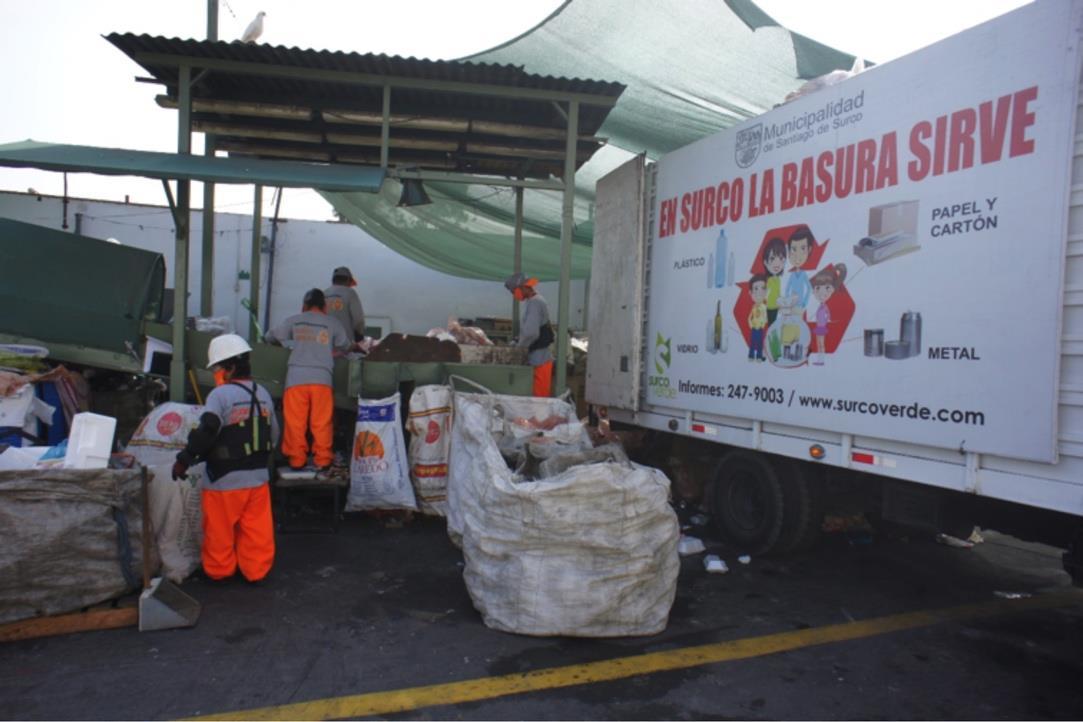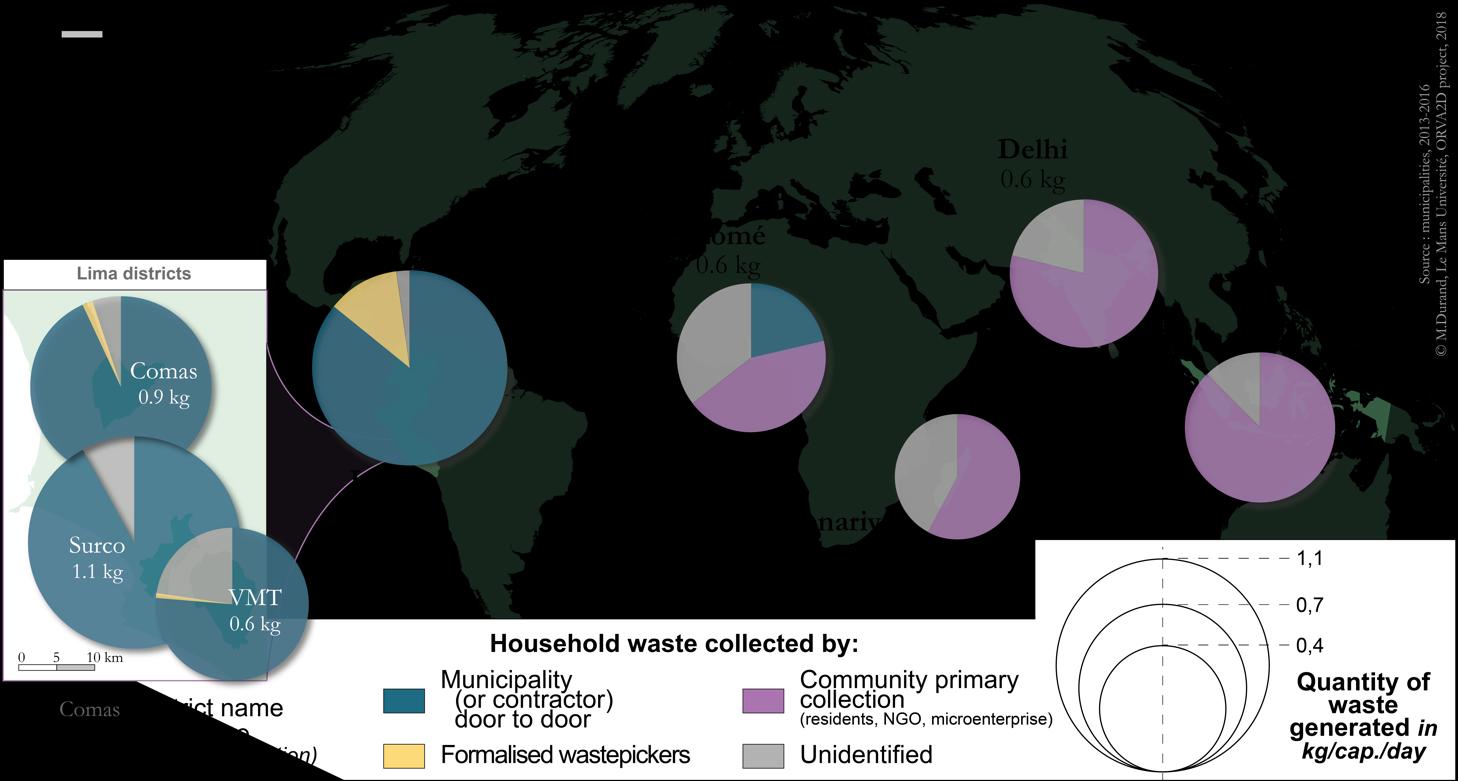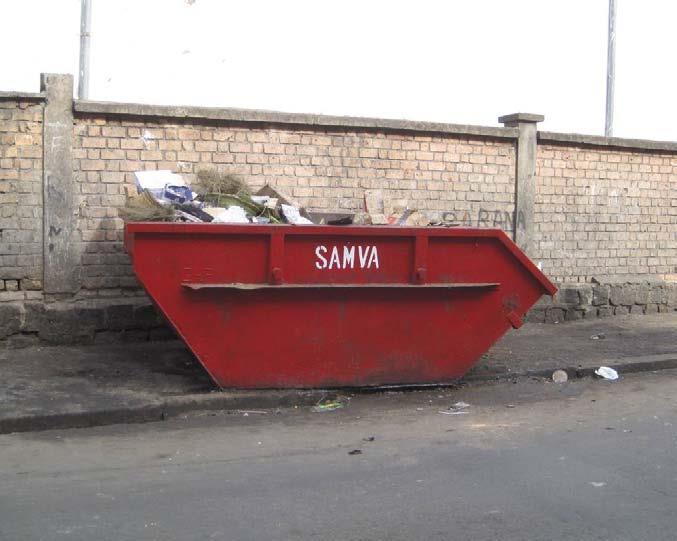
13 minute read
II. Primary collection as an alternative to the municipal service
Photo 1.
Selective waste collection in Surco © M. Rateau, ORVA2D, 2015
Advertisement
Bogotá tried to set up selective waste collection using private contractors for residual household waste (RHW) in 2008. The collection routes then covered 37% of users in sixteen of Bogotá’s nineteen urban localities (UAESP, 2015). This collection service was closed down in 2011 following the move to integrate informal actors (cf. Chapter 2.3.).
In global South countries, municipal services collect the bulk of waste, not through door-todoor collection but via transfer points. Transfer points are somewhat similar to voluntary dropoff points, although the operating principle is very different. In unplanned neighbourhoods, the residents take their waste to the main roads or, when they can afford it, call on primary collectors who charge them a fee for this service. Primary collection not only improves service quality, but also significantly increases the sorting rate and recovery and recycling rate as the primary collectors sell on the materials with added value. Although primary collection is not legal, it is tolerated in most of the cities since it is the only service capable of removing a substantial fraction of the urban waste. There is also a degree of tolerance for the recovery of recyclable waste by primary collectors. Only Delhi continues to implement a totally repressive policy towards its primary collectors. On the contrary, other cities like Lomé or, to a lesser extent, Antananarivo, are trying to structure this primary collection as an effective complement to the public service.
1. Informal primary collection – often still illegal
For the most part, primary collection is still organised informally by the communities themselves. It is carried out by vulnerable inhabitants as a way of earning their livelihood, within local micro-enterprises or residents’ associations. In Delhi, the municipal collection service does not currently operate door-to-door despite its legal obligation to do so. Only 1015% of city centre districts (New Delhi Municipal Corporation) benefited from this type of service in 2017. 1 In the rest of the city, primary collection is a vital complement to the municipal service. It is ensured by informals who are sometimes organised and supported by NGOs, and paid between €1 and €2 a month, directly by households, although the practice may vary depending on the neighbourhood. Dhalaos – i.e., transfer points for the primary collectors –are managed by the municipalities in order to control the cleanliness of public spaces. Even so, this practice remains illegal and collectors sometimes have their equipment confiscated. In Surabaya (Indonesia), primary collection is highly organised, albeit not officially authorised. It is deployed by community organisations (Rukun Warga or RW) and carried out by the neighbourhood’s poorer residents or by waste collectors. They collect the waste using handcarts and take it to one of the city’s transfer points (TPS – Temporary Shelter Facilities).2 These primary collectors, or tenanga penambil as they are called, are paid by the RWs and their level of remuneration varies from one neighbourhood to another. The RW’s administration levies a corresponding user charge on the households. As a result, Surabaya municipality has no data on the organisation of primary collection. What enables this primary collection to function and achieve internationally recognised results is actually the strong local sociability that has its historical roots in the operation of several public services. The city has in fact been awarded several international prizes for the quality of its urban environment. Surabaya municipality then takes responsibility for transporting the waste from the TPSs to the city’s new sanitary landfill.

Photo 2.
Primary collectors at a TPS in Surabaya © Cavé, ORVA2D, 2016
In light of these examples, the neighbourhood appears to be an effective scale for sorting and reducing the waste streams to be transported to the centralised sanitary landfill. What’s more,
1 Field survey conducted under the ORVA2D research project (De Bercegol, 2016). 2 Field survey conducted under the ORVA2D research project (Cavé, 2016).
collecting the service charge from residents for primary collection proves relatively easy. As the service is decentralised, this also means that vulnerable citizens can be provided with work, which is why some cities have tried to organise this type of scheme.

Map 4. Share of primary waste collection in the African and Asian cities
2. Moving towards authorities
primary collection supervised by the public
Many African cities such as Lomé and Antananarivo have introduced a policy to organise primary collection.
Antananarivo: community-based primary collection
In Antananarivo, primary collection is fully integrated into the municipal service as transfer points are structured on a neighbourhood (fokontany) scale. Formalised primary collection was launched by NGOs at fokontany level in the early 2000s.1 It was officially authorised in 2006 by a municipal decree that established a collaboration with the city authorities under the RF2 system. 2 The system operates on the principle of assigning unemployed inhabitants in each neighbourhood to the primary collection service in order to improve cleanliness within a given perimeter. The households pay €0.15 to €0.60 directly to the primary collector. Primary collection operates in at least 145 of the city’s 192 fokontany, but no data exist on its effectiveness within each neighbourhood. Each NGO has set up its own system, with variable results. In some neighbourhoods, the NGO purchases the collection equipment while in others
1 Field survey conducted under the ORVA2D research project (Lecointre, Breselec et Pierrat, 2015). 2 “Rafitna Fikajana ny Rano sy ny Fakadiovana” translated literally means “cleanliness and hygiene of neighbourhood”. my
it is the residents who assume the cost. The practice is not homogeneous and payment of the collection fee is also uneven. There is no door-to-door collection. Apart from removing waste, the primary collectors also seem to be best placed to ensure the collection of recyclable waste, although this mission is not officially entrusted to them by the municipality. However, the support for the primary collection policy indirectly supports the waste-sorting activity. The municipal enterprise (SAMVA) – which does not control primary collection – imposes a charge for all tonnage recovered on the disposal site, notably that of the informal collectors. On the Andralanitra dumpsite, SAMVA has introduced an informal fee on the dump-pickers’ activity as it charges for materials that leave the site through informal channels. The fee amounts are calculated according to the type of material and the quantities involved (e.g., the fee is higher for scrap metal and bones).
Private contracts to structure primary collection in Lomé
In Lomé, two waste collection models co-exist. Some districts (central and wealthier) have the benefit of a door-to-door collection service, whereas the city’s (poorer) northern periphery has to make do with primary collection. All in all, some 650,000 people are covered by primary collection, equivalent to two-thirds of the city’s population. The authorities organise the intervention of primary collectors through tenders for (primary) collection services. In 2015, the municipality divided the territory into 25 lots1 and, based on a competitive bidding process, assigned primary collection for each lot to a micro-enterprise for one year. Each lot covers an average of 25,000 people. The primary collectors collect a fee directly from users, ranging from €2 to €4 per household. In principle, a small fraction of this amount (2-12% depending on the case) is repaid to the municipality to finance collection from transfer points. In reality, however, the municipality finds it hard to collect these funds. The companies are tasked not only with carrying out primary collection of waste and taking it to one of the city’s five transfer points, but also with separating out the recyclables. These materials are then sold directly at the transfer points, which are only accessible to associations and micro-enterprises recognised by the municipality. For this purpose, the city has created premises, known as “déchetteries” (household waste recycling centres) to house the recyclables near to the transfer points. Logistics facilities are thus set up even though this mission and the associated actors are not officially recognised. It should be noted, however, that the design of the city’s transfer points has not yet been optimised as formalised primary collectors still tip part of their waste onto wild dumpsites. As the removal of waste from these transit points, which is ensured by the municipal service, involves a large amount of sand, the useful life of the official landfill site is considerably shortened.
3. Making transfer points into choice places for recovery
Field observations highlighted a type of infrastructure that is becoming increasingly widespread (and gradually being improved): transfer points. In 2017, German cooperation came to the same conclusion. 2 Designed to assemble wastes before their evacuation, transfer points are set up at the neighbourhood or street level and offer several advantages not only for waste collection and sorting, but also for social integration between communities and the sector’s actors. In situations where door-to-door collection is rare, it is vital to ensure the interface between primary collection and the transport of waste to a site for final treatment. However,
1 Field survey conducted under the ORVA2D research project (Garnier, 2016). 2 Participation of W. Pfaff-Simoneit at the conference “En quête d’innovation: valorisation des déchets dans les villes du Sud”, 9 June 2017, AFD (Paris), which concluded the ORVA2D research project.
transfer points can quickly turn into unsanitary monitored. wild dumpsites if they are not carefully
In Delhi, each of the city’s five municipalities has divided its territory into several lots, with the waste collection service in each being assigned to private contractors (except for several lots directly managed by the municipalities). The companies collect waste from the transfer points (dhalaos), but are not responsible for transporting it to these points. For example, South Delhi Municipality, which counts 5.6 million of the city’s 16 million inhabitants, has 1,096 dhalaos. Each facility measures around 60 m3 and is sized to store the waste generated by 10,000 to 15,000 people. Some municipalities are also thinking of creating transfer centres that would enable the collected waste to be transferred into larger trucks before being transported to the final sink option (landfill or incineration), which would thus reduce transport costs. In Surabaya, there are 173 official transfer points (TPSs). These are no longer places where waste is simply deposited, but real sorting centres at the disposal of the neighbourhood’s primary collectors. With a surface area of 100 to 300 m2 , they can house the waste of around 10,000 people. Community associations (rakun warga) have strong incentives to sort waste (both financially and in terms of social recognition). In Antananarivo, the municipality estimates that only 55% of generated waste is collected. This is deposited at transfer points, comprising 325 skips and, in some cases, concrete-built facilities. The deposited waste is then collected by private contractors on an irregular basis depending on how quickly the point fills up, then transported to the municipal landfill. The contractors are paid according to the tonnage collected and the kilometres travelled. In some peri-urban settlements, however, the transfer points are too far away for the residents, who then have no choice but to resort to fly tipping or wild dumpsites1 to discard their waste. A further problem is that transfer points become saturated given that they are not easily accessed by collection trucks and that the space in inadequate. This is particularly the case in the city centre and around marketplaces. 2

Photo 3. A waste transfer point in Antananarivo © Pierrat, ORVA2D, 2015
The two Latin American cities are little concerned by this type of infrastructure since door-todoor collection is found almost everywhere (over 85% of waste collected). Even so, Lima and Bogotá municipalities are mulling several questions that could well be resolved by this type of
1 Fly tipping is small-scale and temporary (alongside a transport route), whereas a wild dumpsite is long-term, larger and generally located away from transport routes. 2 Field survey conducted under the ORVA2D research project (Lecointre, Breselec & Pierrat, 2015).
facility. Currently, their main issue is how to transport their waste to the landfill sites located on the city outskirts. The haul time and transport costs are very high given the absence of transfer station (only a few wealthy neighbourhoods in Lima have built their transfer station – signalling the persistent inequalities that strongly impact this city). These stations mean that waste can be transferred from a small collection truck manned by one driver and a crew of two or three loaders onto larger trucks that only require a driver, which helps to reduce costs. There is also a move to group together formalised wastepickers in collective facilities so that they can add value to their recyclables before selling them on to wholesalers. Transfer points could also allow for local composting, which would avoid the transport of highly biodegradable waste. For the time being, this potential is still underexploited. Organic waste recovery is found at a few primary collection points in Antananarivo, but is widespread in Surabaya. It is being planned in Lomé. Avoiding the transport of organic waste reduces health hazards linked to runoff and fermentation. It also offers the possibility of re-using the compost locally (for green spaces), whereas large centralised stations find it hard to sell their large stocks of compost (cf. Chapter 3).
4. Competing projects for certain types of waste
In the cities where the only effective recovery channel is informal recycling, competition exists not only among the various recyclers, but also with other projects backed by public authorities, private companies or NGOs. A case in point is the competition between the primary collection service supported by Antananarivo municipality and projects backed by international NGOs (e.g., East, Enda, Care) to recover the fraction of recyclable or organic waste. In Peru, the only case of competition between two projects is in Surco, where the legislative incentive to integrate informal wastepickers (cf. Chapter 2.3.) is at odds with the district’s drive to deploy policies akin to those of rich countries by ousting the informal actors (municipal selective collection). In other cities, competition with private companies is strong and involves very different and conflicting models. In Bogotá, for example, competition exists between the informal but highly organised wastepickers and the service companies that were awarded collection contracts (notably for selective collection). This was the source of the legal battle before the Constitutional Court (judgement no. 275 of 2011) (cf. Chapter 2.3.), which ruled that the municipality was obligated to organise the sharing-out of these collection services. In Delhi, the informal sector is encountering an increasingly intolerant attitude from the authorities, as its activity competes more and more with private firms providing door-to-door collection and incineration services (cf. Chapter 3). At least 50,000 informal street pickers roam the city (of over 16 million inhabitants) to retrieve recyclable waste from household dustbins. This waste is then sold on to local traders before being transferred to specialised neighbourhoods where the materials are sorted, cleaned and processed in makeshift workshops. Recovery is a source of income for thousands of street-pickers, who contribute to a waste recycling economy that creates work for several hundreds of thousands of other Delhi citizens. This type of recovery, however, conflicts with the private operators in charge of waste incineration, who refer to the new solid waste management rules (MSW rules 2016) recommending the implementation of door-to-door waste collection. The authorities’ positioning vis-à-vis the informal sector is often ambivalent, even contradictory (when comparing discourse and practice). Apart from Bogotá, the authorities know little about informal recovery channels and find it hard to control their economic, social and environmental impacts. Although the authorities’ first tend to try and eliminate the informal sector, which is perceived as archaic and degrading, since the mid-2000s they have been increasingly inclined










